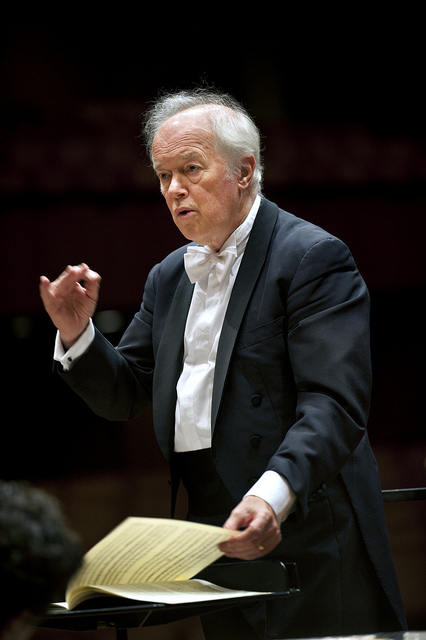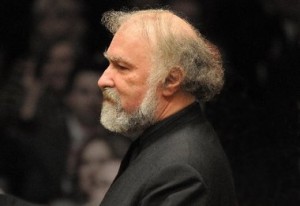Music minus Muti: de Waart fills in admirably for CSO’s Beethoven program

The sense of disappointment was palpable Thursday night at Symphony Center with a rare packed house full of people that expected to hear Riccardo Muti lead off the Chicago Symphony Orchestra’s first concerts of 2013.
Instead, felled by the flu, an ailing Riccardo Muti bowed out of this opening week of his winter residency. While the situation is no one’s fault in this virulently epidemic flu season, some people understandably wonder why the CSO music director also bailed out of next week’s concerts so early—Muti flew back to Italy on Tuesday—rather than stay in Chicago and perhaps recover enough to conduct his second scheduled program. (As of now, Muti still plans to conduct the CSO’s three-week Asian tour that starts later this month.)
Fortunately, the CSO was able to secure the services of Edo de Waart for these first two programs of the new year. Currently music director of the Milwaukee Symphony Orchestra and chief conductor of the Royal Flemish Philharmonic, the respected Dutch conductor hasn’t directed a downtown CSO concert in a quarter-century. And while this week’s fraught circumstances—exacerbated by a Wednesday performance and even briefer rehearsal week than usual—produced inevitably mixed results, de Waart led the orchestra with admirable professionalism on short notice.
The evening’s all-Beethoven program opened with the Leonore Overture No. 3, the longest and most elaborate of Beethoven’s curtain-raisers for his sole, much-revised opera, Fidelio. De Waart flirted with stasis in his spacious handling of the introduction, yet handled the transition into the Allegro deftly and drew a worthily rousing coda, though overall this episodic performance lacked cohesion. Mathieu Dufour and Christopher Martin provided superb contributions, with the latter’s offstage trumpet call supple and atmospheric.
The major work of the evening, Beethoven’s Eroica symphony, began in unprepossessing fashion. Setting a brisk pace in the opening Allegro, de Waart directed a solidly played account that felt like a respectable run-through—which, in all probability, it was, due to the circumstances. Straitened in dynamics and generalized in expression, lacking detailing and nuance, this Eroica sorely needed a sense of danger and revolutionary spirit.
The ensuing funeral march began in similarly anodyne mode, apart from Eugene Izotov’s first-class oboe contributions. Yet halfway through this brooding music, the switch seemed to get flicked on and the performance found its footing. De Waart drew a forcefully pungent climax and the orchestra distilled a striking sense of disconsolate mystery in the ebbing away of the coda.
The Scherzo leaped out of the gates with an incisive burst of energy and what a pleasure to hear the CSO horns tackle the trio section with their old polish and panache. De Waart pointed up the balletic connection in the main theme of the finale’s variations—a self-crib from Beethoven’s Creatures of Prometheus—with fleet, lightly pointed playing. The ensuing permutations were vividly characterized and there were several nice touches—as with the strings’ delicacy in the running fugal passages—the punchy, dynamic orchestra playing building inexorably to a resonant coda.

Radu Lupu was solo protagonist in the evening’s centerpiece, Beethoven’s Piano Concerto No. 1 (the second to be composed, but never mind). The Romanian pianist performed another Beethoven concerto in his last CSO appearance two years ago—a rather uninspired account of No. 3.
Seated in his usual high-backed chair, Lupu’s playing of Beethoven’s Piano Concerto No. 1 Thursday night was strikingly similar to that of the C minor concerto in 2010, with light, even feathery articulation and a distinctly Rococo touch.
Lupu, 67, was never a power player even in his prime, but a more robust approach at times would have been welcome. His light articulation in the first movement made it seem even more like Mozart’s 28th piano concerto than usual. The lack of muscle, wispy projection and some rhythmic instability in the Rondo—Beethoven’s wittiest concerto finale—short-sheeted the bumptious humor and gear-shifts that continually upend the main theme.
The pianist’s elegant approach worked best in the long-breathed Largo. distilling the ruminative main theme with an affecting poignant simplicity.
The program will be repeated 8 p.m. Saturday, and 7:30 p.m. Tuesday. cso.org; 312-294-3000.
Posted in Uncategorized





Posted Jan 13, 2013 at 8:16 pm by Charles Amenta
I used the word “rococo” when describing the Lupu performance that I heard last night (Sat 12 Jan to my son–so it must be that great minds think alike. The performance had its charms–yes, the Larghetto–but seemed a bit pallid for Beethoven. This was not surprising given how *un* appassionato his solo performance of that sonata was a few years ago. It would have been interesting to hear how Muti would have accompanied Lupu. De Waart seemed simpatico with the reduced dynamics.